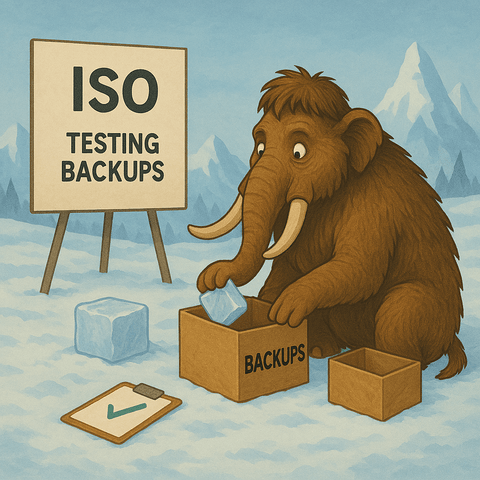Why ISO 27001 Compliance Matters – And Why Backups & Recovery Testing Are Non-Negotiable
In today’s digital world, cybersecurity isn’t just an IT issue — it’s a business imperative. Customers, partners, and regulators expect companies to take security seriously, and few signals demonstrate that commitment better than ISO 27001 certification.

30 March 2025
This internationally recognized standard lays out what an effective Information Security Management System (ISMS) looks like. And while it covers a wide range of controls, one area is often underestimated in practice: backups and recovery testing. Let’s explore why compliance with ISO 27001 matters — and why getting backups and recovery right could be the difference between a minor incident and a business-ending disaster.
ISO 27001 – A Quick Recap
ISO 27001:2022 is the latest version of the standard for information security management. It helps organizations of all sizes systematically manage sensitive data, mitigate risk, and stay resilient.
The 2022 update modernized the framework by aligning it more closely with today’s threats and technologies, placing greater emphasis on areas like cloud security, threat intelligence, and business continuity.
Backups and recovery fall squarely under Annex A.8: Technological controls, specifically:
- A.8.13: Information backup
- A.8.14: Redundancy of information processing facilities
Why Backups Are Central to Compliance (and Survival)
You can have the most advanced firewalls, threat detection systems, and encryption protocols in place — but if your data disappears and you can’t get it back, your business grinds to a halt.
Backups are your safety net. ISO 27001:2022 requires that organizations:
- Have regular backups of relevant information
- Ensure backups are protected against unauthorized access and modifications
- Retain backups in accordance with legal and business requirements
- Regularly test restoration capabilities
But here’s where many organizations fall short: they don’t test their backups...
Recovery Testing: The Often-Ignored Piece
Creating backups is one thing. Restoring them under pressure — during a real incident — is another.
ISO 27001 doesn’t just ask whether you have backups. It asks whether you can use them effectively when it counts. That’s where recovery testing comes in.
Recovery testing answers critical questions:
- Can we restore data within our Recovery Time Objective (RTO)?
- Is the restored data accurate and complete?
- Are our backup procedures reliable and documented?
- Are we backing up the right systems and data?
Best Practices for Backup & Recovery Under ISO 27001:2022
To stay compliant and resilient:
- Define a clear backup policy. Outline what gets backed up, how often, retention times, and responsibilities.
- Use encryption and access controls. Protect backup data at rest and in transit.
- Automate where possible. Reduce human error and ensure consistency.
- Store backups offsite or in multiple zones. Guard against physical disasters.
- Test recovery procedures regularly. Include full restores, partial restores, and scenario-based testing.
- Document everything. Keep records of backup schedules, test results, issues, and improvements.
Make sure to have an inventory of all data that need to be included in the backup.
Don't forget about external data and vendors.
Also make sure you are alerted when a backup is failing. Use monitoring tools that can alert you when a periodical tasks fails, like the Semonto cron job monitoring.
Compliance Is Just the Beginning
Meeting ISO 27001 standards isn’t just about checking boxes — it’s about building trust. Customers and partners want to know that if something goes wrong, you’re in control. A solid backup and recovery strategy proves that.
More importantly, it’s about business continuity. Cyberattacks, human error, hardware failures — all of these are inevitable. What matters is how quickly and reliably you bounce back.
A recap
- ISO 27001:2022 raises the bar for information security.
- Backups are required — but tested recovery procedures are what make them useful.
- Regular testing, strong access controls, and documentation are key to compliance.
- Strong backup and recovery = resilience, trust, and peace of mind.
Need help reviewing your backup strategy for ISO 27001 compliance?
We’re here to help — get in touch. We focus on SaaS companies and startups!